Can you guess which vegetable was once proclaimed the “king of vegetables,” can help reduce the risk of birth defects for pregnant women, helps manage PMS symptoms, prevents progression of cataracts and even fights cancer? Sound too good to be true?
Believe it or not…it’s asparagus!
With all of these powers plus more, and since asparagus season is rapidly approaching, it’s the perfect time to talk about all this “super vegetable” has to offer!
Maybe you are like us and are already crazy about asparagus! Or, maybe you have tried it a time or two and just haven’t found an inspiring preparation. Or, maybe it’s one of those foods you THINK you don’t like. We hope to give you some reasons and ideas to enjoy this incredible vegetable…maybe even more than you already do!
Where does asparagus come from?
 Asparagus was actually cultivated 2,500 years ago in Greece. Greeks used it as an herbal medicine and many medicinal benefits still exist. Asparagus is within the same vegetable family as onions, leeks, and garlic.
Asparagus was actually cultivated 2,500 years ago in Greece. Greeks used it as an herbal medicine and many medicinal benefits still exist. Asparagus is within the same vegetable family as onions, leeks, and garlic.
It is grown by planting a crown a foot deep in the soil, and then each crown will produce spears of asparagus for 6-7 weeks during the spring and early summer. The season for asparagus is April through June, depending on where you live. Early in the season, asparagus is picked every 4-5 days. Then, as the temperatures get warmer, the spears grow faster…as much as 10 inches in 24 hours! At its peak, it often has to be harvested every day. Asparagus plants can produce every year for 15 years or more!
The U.S. imports the majority of its asparagus, much of it from Peru and Mexico. These imports during the peak season drive costs down, making it difficult for U.S. producers to compete. The majority of the U.S. asparagus is grown in just a few states…California, Washington, and Michigan. Of course, many local farmers grow asparagus and sell it at farmers’ markets or through local co-ops. No surprise…we HIGHLY RECOMMEND buying in-season asparagus from your local farmers!
Why asparagus?
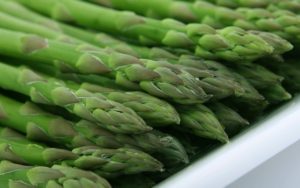 Asparagus is absolutely loaded with nutrients…if you look at nutrients per calorie, asparagus is at or near the top of the list! It includes fiber, folate (much needed during pregnancy), tons of vitamins such as Vitamins B, C & E, a whopping punch of Vitamin K, and is an excellent source of potassium, which is important for a healthy blood pressure and strong heart.
Asparagus is absolutely loaded with nutrients…if you look at nutrients per calorie, asparagus is at or near the top of the list! It includes fiber, folate (much needed during pregnancy), tons of vitamins such as Vitamins B, C & E, a whopping punch of Vitamin K, and is an excellent source of potassium, which is important for a healthy blood pressure and strong heart.
Asparagus also is an excellent anti-inflammatory food and helps fight cancer with a very powerful antioxidant called glutathione, which destroys carcinogens in our bodies and helps protect our skin. It just keeps getting better — asparagus is low in calories, only 20 per serving, and is very low in sodium!
How do you choose it?
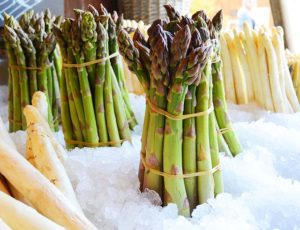 Asparagus is available in different varieties…green, white and purple, with green being the most common. White is the same variety as green, but is grown without exposure to the sun. Purple is a different variety, which can be slightly sweeter and it typically turns green when cooked.
Asparagus is available in different varieties…green, white and purple, with green being the most common. White is the same variety as green, but is grown without exposure to the sun. Purple is a different variety, which can be slightly sweeter and it typically turns green when cooked.
We have found that the farmers’ market is the perfect place to find fresh, in-season green and purple asparagus, often harvested from the field within the last 12 hours! When selecting asparagus, you know it is fresh if it snaps when it is bent — you don’t want it wilted or limp. If you are buying the green variety, it should be bright green with purplish tips.
How do you store it?
The best way to store asparagus and keep it fresh for at least a week:
 Keep the asparagus in the bunch.
Keep the asparagus in the bunch.- Trim stem ends if rough and dry.
- Place the bunch of asparagus upright in a mason jar, cup, or bowl (you want to keep the bunch standing upright) and fill with about one inch of water. You don’t need to completely cover the asparagus with water, just enough to keep the stem ends moist.
- If desired, you can cover the top of the asparagus loosely with a plastic bag. (This will keep the asparagus tasting fresh and keep it from taking on the taste of other foods in your refrigerator).
- Store in the refrigerator until ready to use!
Let’s get cooking…how do you prepare it?
There are many ways to prepare asparagus…roasted in the oven, blanched, steamed, sautéed, grilled or yes, it also tastes great raw! A couple of our favorite ways to cook asparagus are roasting and grilling. Many people think asparagus tastes better when cooked, even for just a few minutes, but like with all vegetables, you should experiment and find the preparations you like best!
Here are just a few incredibly delicious ways to enjoy fresh, in-season asparagus!
 Asparagus with Catalan Vinaigrette
Asparagus with Catalan Vinaigrette- Spring Asparagus Farro Salad
- Savory & Simple Roasted Asparagus
- Springtime Strawberry Couscous Salad
- Caesar Style Grilled (or Roasted) Asparagus
- Spring Inspired Cobb Salad
- Lamb Meatballs with Mint Pesto Pasta
- Veggie Skillet Lasagna
- Green Shakshuka
- Asparagus Lentil Salad
- Simple Roasted Asparagus & Mushrooms
 Shallot, Asparagus & Sun-Dried Tomato Pizza
Shallot, Asparagus & Sun-Dried Tomato Pizza- Curried Asparagus & Chickpeas
- Egg-Topped Roasted Asparagus & Strawberries
- Shaved Asparagus Pizza
- Roasted Strawberry & Asparagus Salad
- Kale & Asparagus Farro Salad
- Roasted Chickpea & Asparagus Potato Salad
- Hearts of Palm, Jicama & Asparagus Salad
- Lamb Crostini with Asparagus Gremolata
- Asparagus Stuffed Sweet Potato
- Spring Vegetable Orzo Pasta Salad
- Greek Style Frittata
…and so many more!
A coaching tip on asparagus wouldn’t be complete without addressing that awkward issue…maybe you have heard about it…
asparagus pee?
Not that we make a habit of smelling or talking about our urine, but just in case you have ever wondered when you eat asparagus…“what is that funny smell?” You are not imagining things! Asparagus contains an acid that breaks down into sulfur-containing compounds that can vaporize when exposed to the air. This is why you may notice a distinct smell, but don’t worry, it is not harmful! And, don’t be concerned if you don’t smell anything – not everyone does! Scientists continue to debate whether people who can’t smell it don’t produce it or simply don’t smell it. And, now you know!
Now, let’s get back to the more appetizing side of asparagus!
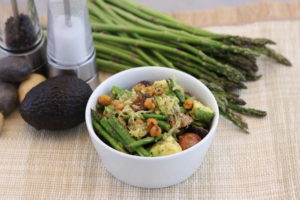 April is a perfect time to give yourself a challenge!
April is a perfect time to give yourself a challenge!
Serve asparagus at least one day a week for the entire month in ALL kinds of different ways. Get your whole family involved and vote…is it a “keeper” or “sleeper?” From adding to salads, stir-fries, pizza and other meals, we are confident you will find some great, new asparagus recipes your whole family will enjoy! If nothing else, try asparagus roasted or grilled…we think your taste buds will thank you!
 LEARN MORE ABOUT THE NAPKIN!
LEARN MORE ABOUT THE NAPKIN!

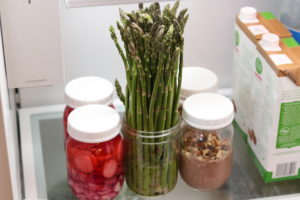
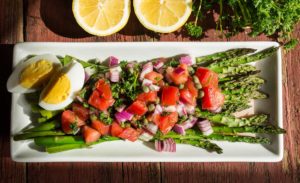

Asparagus? Yes, please! We have several favorite Eat Real asparagus recipes! Wish the season was longer! Is there a way to freeze it and not make it mushy?
I LOVE, LOVE, LOVE, asparagus, for all of the reasons listed! When it’s in season, it’s always in my fridge, and I even buy it off season when the price is reasonable. Many years ago, when I was in the advertising business, I created an award-winning campaign — Every Inch Edible — for Michigan Asparagus. Can’t wait to try more of the recipes listed. Roasted Asparagus and Mushrooms is one of my favorites. Also, Veggie Skillet Lasagna.
This is a wonderful list of asparagus recipes–many of them already our favorites, including Asparagus with Catalan Vinaigrette. I’ll have to check to see if we’ve missed any!
To bump up the caramelization of roasted asparagus, put the empty pan in the oven while heating the oven, then add your seasoned asparagus to the HOT baking pan, pop it in the oven for the desired cooking time, then enjoy!
I have tried asparagus many ways many times and I just can’t do it. I’ve tried it over the 12 times. I can get one or two stalks in if it is grilled. Would love to like it more. Any ideas?